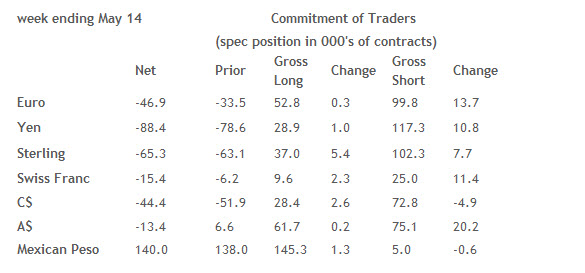The US dollar posted strong across-the-board gains this past week. It is being driven by the anticipation of favorable developments in the US, in the form of a possible slowing of the Fed's asset purchases, and less favorable developments abroad.
While it is technically poised for additional gains, the biggest risk to the dollar comes from Fed Chairman Bernanke's midweek testimony. His commitment to QE and readiness to taper purchases, as others have suggested, will be closely scrutinized. The failure to confirm these growing market ideas, spurred in part by comments from two (non-voting) regional Fed presidents, could prompt some profit-taking on long dollar positions.
While speculation that the Fed may take one of its feet off the accelerator in the next week or month helped lift the dollar, other countries are easing policy. There has been even more talk about the ECB adopting a negative deposit rate. Continued sub-50 readings in the flash PMI, due midweek, will heighten the sense that the eurozone continues to contract for the seventh consecutive quarter.
The ongoing decline in the yen is meeting little official resistance. Chinese officials, for example, seem more upset by comments by the mayor of Osaka (which the US also criticized for being "outrageous") then they were about the depreciation of the yen. The US Dollar Index has risen 3.7% from the low on May 1 to its best level since 2010, and is recording its best two week run in a year.
Euro: A large head and shoulders pattern is being carved out. The neckline is seen near the late March and early April lows around $1.2740. Below there is the low from last November near $1.2660, which is just below the $1.2680 retracement objective ($1.2680) of Draghi's OMT induced rally. The measuring objective of the head and shoulders pattern would carry the single currency below $1.20, our year-end target. This past week, the euro's 50-day moving average crossed below the 200-day (golden cross) for the first time since last October.
Yen: The pullbacks in the US dollar continue to be shallow. This is not giving the longs any pain and it gives many momentum and trend followers a sense that it is a one way bet, a mindset that often proves dangerous. Support now is seen in the JPY102.35-60 area. Although there are reports of option structures before, many have their sights set on JPY105.
Sterling: The upside correction from the mid-March low near $1.4830 has ended decisively. That correction had held an up trend line, which sterling closed below at the start of the past week near $1.5350. A convincing break now of the $1.5120 area suggests a return to, and likely a break of, this year's low. Sterling has also broken below a trend line connecting the lows of the past three years. This sours the longer-term outlook and warns of a move toward $1.42.
Canadian dollar: The US dollar is flirting with trend line resistance against the Canadian dollar going back to 2011. The year's high was set on March 1 near CAD1.0340. A break of it opens the door for a move toward CAD1.05-CAD1.06.
Australian dollar: The Aussie has fallen out of favor in a big way. It has been aggressively sold-off; the largest decline over a 10-day period in more than a year and a half. It has convincingly broken a trend line drawn off the 2011-2012 lows that came in just above $0.9800. An investment bank called for a move to $0.8000. This corresponds to the 2010 lows and a 61.8% retracment of the post-Lehman rally. It may be a reasonable longer-term objective, and by the OECD's purchasing power parity model, the Australian dollar is almost 30% over-valued. However, given the difficulty in forecasting exchange rates and the substantial risks that are involved, as well as mitigating factors like Australia's triple-A credit rating and a currency that is gaining recognition as a reserve asset, we suggest medium term investors should anticipate half of that move, or $0.8900-$0.9000 and place stops accordingly.
Mexican peso: Over the past year, the Mexican peso has appreciated by 11.5% against the US dollar, making it the strongest among the G7 and liquid emerging market currencies. While we recognize attractive underlying fundamentals, technical factors have made us more cautious. A dollar bottom has been carved out over the past month. The long peso position remains large and a move above MXN12.40 could spur a further dollar short squeeze. A correction could carry the greenback into a MXN12.60-MXN12.80 range.
Observations from the latest CFTC report of the CME currency futures:
- Participation rose as new gross positions were established across the board, with two minor exceptions, short Canadian dollar and short Mexican peso positions were trimmed.
- There were 4 substantial (more than 10k contracts) position adjustment and they were all adding to the gross short positions: euro, yen, Swiss franc, and Australian dollar.
- The 36% rise in gross short Australian dollar positions to a record 75.1k contracts was sufficient to switch the net position to the short side for the first time since last June. Nevertheless, the gross long position remains the second largest among the currency futures, behind the Mexican peso.
- The gross short euro position is just below 100k contracts. Last June, as the tensions were mounting that led to the Draghi's OMT offer, the gross short position was 250k contracts. The gross short sterling position is approaching the record from March of 105k contract. The price action and the increase in open interest since the CFTC period ended suggests new shorts have been established.

